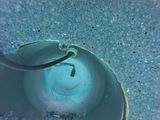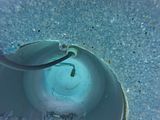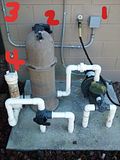Hello,
We purchased our home about a year ago with an existing inground pool. The pool light did not work during one of the pre-purchase walkthroughs so we asked for it to be fixed. It was operating during our final walkthrough before closing and for awhile after we purchased the house. Our pool is looking so good I really want to have a light so we finally pulled it out yesterday to take a closer look. Amazingly, there was only a small amount of algae in there
I have attached photos of all the parts of the light. Obviously, the light burned out due to water in the housing. Overall, the parts look pretty good but I will your advice regarding what to replace to make it watertight. The info on the housing indicates it was manufactured in June 2004. It is 120 V, 400W that uses an R-40 bulb with 1/2" cable.
The info on the housing says it had 30' of cable. There is barely enough cable to place the light onto the deck so I'm confused about the 30' of cable. There is some sort of electrical box looking thing about 8-10' away from the pool (see photos). Does the cable go back to that box? We have an on/off switch in the house and a breaker with GFI (looks new) on the side of the house by the pump (see photos).
Do I try to fix it or must I purchase a whole new light assembly?















We purchased our home about a year ago with an existing inground pool. The pool light did not work during one of the pre-purchase walkthroughs so we asked for it to be fixed. It was operating during our final walkthrough before closing and for awhile after we purchased the house. Our pool is looking so good I really want to have a light so we finally pulled it out yesterday to take a closer look. Amazingly, there was only a small amount of algae in there
I have attached photos of all the parts of the light. Obviously, the light burned out due to water in the housing. Overall, the parts look pretty good but I will your advice regarding what to replace to make it watertight. The info on the housing indicates it was manufactured in June 2004. It is 120 V, 400W that uses an R-40 bulb with 1/2" cable.
The info on the housing says it had 30' of cable. There is barely enough cable to place the light onto the deck so I'm confused about the 30' of cable. There is some sort of electrical box looking thing about 8-10' away from the pool (see photos). Does the cable go back to that box? We have an on/off switch in the house and a breaker with GFI (looks new) on the side of the house by the pump (see photos).
Do I try to fix it or must I purchase a whole new light assembly?





















